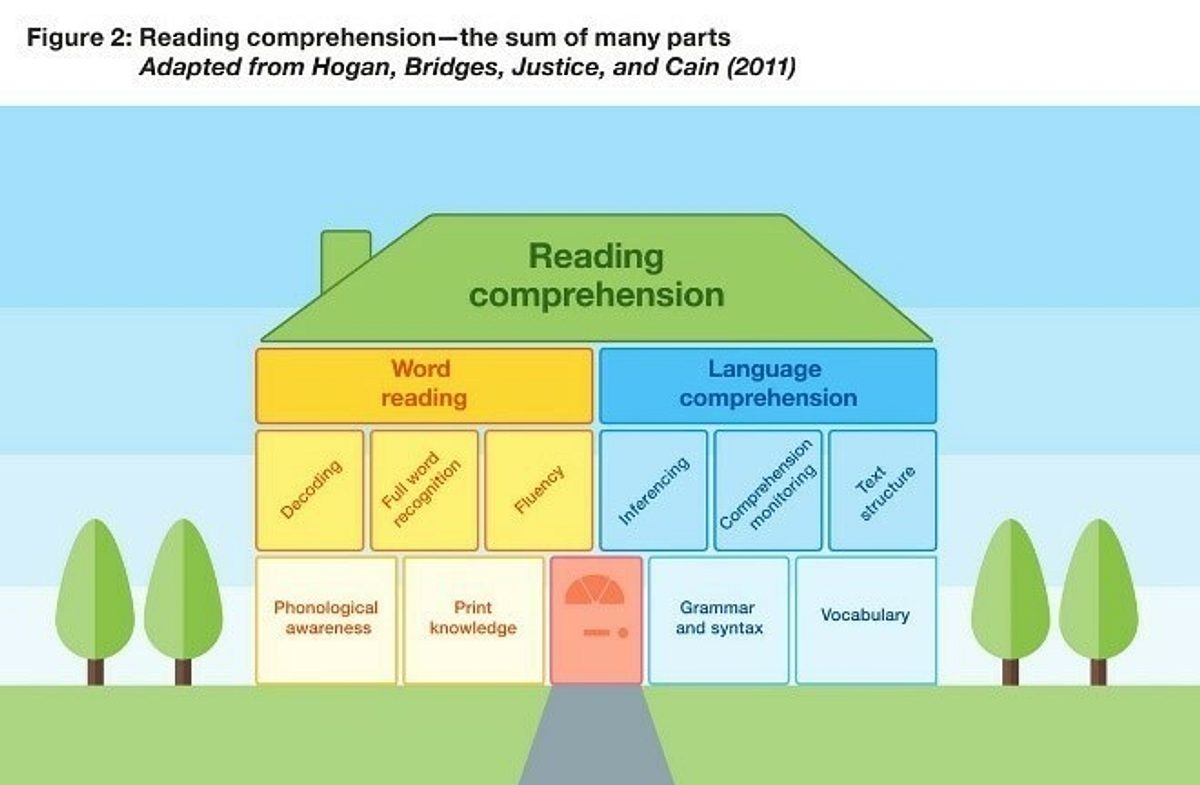My Year 5 class are beginning The Nowhere Emporium by Ross McKenzie. In our first lesson, we’ll explore how the author builds a mysterious opening to the story.
I reread the second sentence in the book:
‘Word travelled quickly around the village, and by midday the place was abuzz with rumour and hearsay.’
Hang on: I’ll need to teach some vocabulary here. I scan the rest of the passage for potential ‘Tier 2’ words that appear frequently across several topics in the classroom: ironmonger’s, emporium, jostled, theories, intricate, spectacle.
I’m already asking myself two questions before I can even think about my lesson:
Can my class read all these words?
Do they have any idea what the words mean?
The ‘Reading House’
Reading is a complex skill, requiring coordination of several cognitive processes. To access this particular text, my pupils need the ‘mechanics’ of word reading sorted: decoding, fluency, and more. To fully grasp the text, they also need to know most of the vocabulary. They need to understand the grammar and syntax. They must learn how to connect ideas as we read.
The reading house model (adapted from Hogan, Bridges, Justice and Cain’s 2011 publication), offers a simple and concrete way we can think and speak about these multiple cognitive processes. It shows word reading and language comprehension as the two dimensions of reading that come together for successful comprehension.

Vocabulary in the House of Reading
Like most houses, the reading house has a door. We can enter the reading house and explore the building blocks just as we could explore rooms that make up a real house.
As we enter each of these ‘rooms’, we can break down the smaller bricks that hold up the reading house. For example, within Phonological Awareness, we might identify more granular elements that feed into our teaching:
Phoneme isolation, addition and substitution (manipulating individual sounds in words)
Segmentation (breaking down words into separate sounds)
Blending (merging individual sounds in a word)
We can similarly break down Vocabulary as an umbrella term into more granular bricks:
Semantics (what a word means)
Orthography (how the word is written)
Phonology (how the word sounds)
Let’s start with semantics – word meanings.
In the reading house model, the vocabulary block is in the Language Comprehension ‘wing’. To fully understand a text, children will need to know the meanings of the words it includes.
Consistent research evidence indicates that the more words a reader can read, know and understand, the more they can develop new word meanings. In other words, the relationship between vocabulary learning and reading comprehension is a reciprocal one. Semantic vocabulary knowledge supports good reading comprehension. At the same time, good reading comprehension offers opportunities to learn new word meanings.
The opposite is also true. As we might expect, children with poor reading comprehension typically have lower levels of vocabulary knowledge. Poor vocabulary limits access to texts, which reduces opportunities to learn new word meanings – and so on.
Let’s now think about the other aspects of vocabulary knowledge: orthography and phonology.
When reading, at some point we will encounter vocabulary where the spelling (orthography) and sound patterns (phonology) of words are inconsistent, such as exception words.
Some early evidence [1] shows that knowing the meaning of the vocabulary has been seen to support children’s recognition of these irregular words. This emerging body of evidence suggests that learning word meanings is not only a building block for language comprehension. The vocabulary ‘room’ of the reading house is also a possible doorway into other parts of the house, including those in the Word Reading wing.
Implications for Practice
We know that teaching vocabulary is crucial to support successful reading comprehension, and potentially word recognition. But what does this mean for me, planning for my Year 5 class?
I started by identifying the Tier 2 words in The Nowhere Emporium. What now?
The EEF’s suite of literacy guidance reports offers evidence-informed recommendations. Three key principles from the Key Stage 2 report that might help me here are:
1. Pre-teach new vocabulary
“Pre-teaching and discussing new words can support reading comprehension (see Figure 4).”
2. Plan repeated exposures
“Repeated exposure to new vocabulary is necessary across spoken language, reading, and writing.”
3. Make it memorable
“Teaching vocabulary and spelling related to the curriculum content currently being studied can encourage active use of new words, helping to make new vocabulary meaningful and memorable to pupils.”

What next?
Look out for our next blog, “Through the Keyhole Part 2”, which explores vocabulary and background knowledge in more depth.
References
[1] ‘Vocabulary is Important for some, but Not all Reading Skills’ Ricketts, Nation and Bishop (2007) SCIENTIFIC STUDIES OF READING, 11(3), 235 – 257, Lawrence Erlbaum Associates, Inc
Literacy_Development_Evidence_Review.pdf (educationendowmentfoundation.org.uk)
